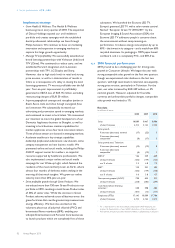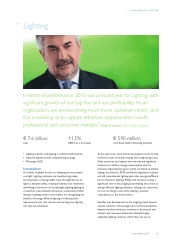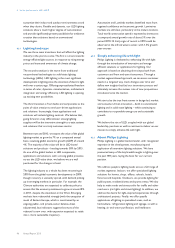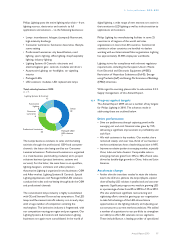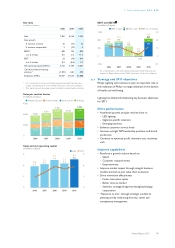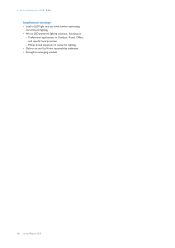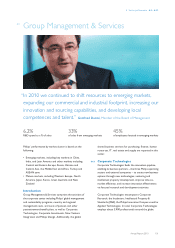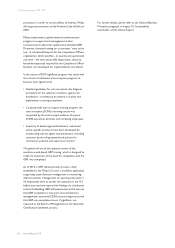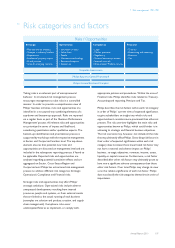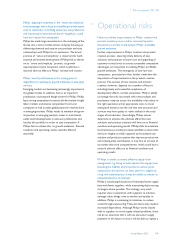Philips 2010 Annual Report Download - page 102
Download and view the complete annual report
Please find page 102 of the 2010 Philips annual report below. You can navigate through the pages in the report by either clicking on the pages listed below, or by using the keyword search tool below to find specific information within the annual report.6 Sector performance 6.4.1 - 6.4.3
102 Annual Report 2010
Corporate Technologies actively participates in ‘open
innovation’ through relationships with academic and
industrial partners, as well as via European and regional
projects, in order to improve innovation efficiency and
share the related financial exposure. The High Tech
Campus in Eindhoven, the Netherlands, the Philips
Innovation Campus in Bangalore, India, and Research
Shanghai, China, are prime examples of environments
enabling open innovation. In this way, we ensure
proximity of innovation activities to emerging markets.
Philips Research is a key innovation partner for Philips’
business sectors. It has three main roles. Firstly, it creates
new technologies that help to spur the growth of the
Philips businesses. Secondly, it develops unique
intellectual property (IP), which will enable longer-term
business and creates standardization opportunities for
Philips. Lastly, it prepares the ground for the creation of
adjacent businesses in the sectors based on technology-
enabled innovation in strategically aligned application
areas.
In 2010, scientists from Philips Research developed the
first-ever organic light-emitting diode (OLED) module
that can be powered directly from a mains electricity
supply. The prototype opens the door to OLED systems
that can be directly plugged into standard power outlets
without the need for bulky power management circuitry.
This will reduce the bill of materials and simplify luminaire
design for future OLED-based systems aimed at mass-
market general illumination applications. In the Healthcare
area, Philips Research is developing a Radio Frequency
Ablation Cockpit, which covers preparation, planning and
execution of minimally invasive tumor ablation
procedures by clinicians. For therapy planning, the cockpit
leverages the tumor visualization capabilities of pre-
operative CT and/or PET imaging plus automated
generation of target ablation plans. For targeted needle
placement, it combines these with the real-time imaging
capabilities of ultrasound and precision needle-tip
navigation technology based on electromagnetic tracking.
Philips has three incubation organizations: the Healthcare,
Consumer Lifestyle and Lighting & Cleantech Incubators.
The main purpose of the Incubators is to create strategic
growth opportunities for Philips. In some cases, spin-out
or technology licensing is considered. In Healthcare,
Philips made an anchor investment in the healthcare
technology fund Gilde Healthcare III, which has a target
size of EUR 200 million. In Consumer Lifestyle, DirectLife,
launched in 2009, now has over 30,000 active users losing
weight, getting fit and staying healthy. In the second half of
2010, a new Skin Care venture became operational to
help women who are confused about their skin type and
the products they should use. Our novel Crystalize
imaging technology gives women factual, objective
information and better knowledge about their skin so they
can make smarter choices and achieve a more beautiful
skin.
Philips further developed digital pathology solutions to
ease the workload and support decision making in central
and hospital-based pathology departments.
Philips IP&S proactively pursues the creation of new
intellectual property in close co-operation with Philips’
operating sectors and the other departments within
Corporate Technologies. IP&S is a leading industrial IP
organization providing world-class IP solutions to Philips’
businesses to support their growth, competitiveness and
profitability. Philips’ IP portfolio currently consists of
about 50,000 patent rights, 36,000 trademarks, 63,000
design rights and 3,900 domain name registrations. Philips
filed approximately 1,300 patents in 2010, with a strong
focus on the growth areas in health and well-being. IP&S
participates in the setting of standards to create new
business opportunities for the Healthcare, Consumer
Lifestyle and Lighting sectors. A substantial portion of
revenue and costs is allocated to the operating sectors.
Philips believes its business as a whole is not materially
dependent on any particular patent or license, or any
particular group of patents and licenses.
Applied Technologies is a showcase for our open
innovation approach, supporting customers both inside
and outside Philips through new technologies, new
business ideas, consultancy and new product
development and introduction services. Applied
Technologies is an active player in solutions for the
healthcare sector and energy solutions, including solar
cells and energy management.
6.4.2 Corporate Investments
The remaining business within Corporate Investments –
Assembléon – is a wholly owned subsidiary that develops,
assembles, markets and distributes a diverse range of
surface-mount technology placement equipment. In 2010
we announced our attention to sell a majority stake in
Assembléon to H2 Equity Partners, an independent
private equity firm. Philips will retain a 20% stake in
Assembléon once the transaction is completed.
6.4.3 New Venture Integration
The New Venture Integration group focuses on the
integration of newly acquired companies across all
sectors.


